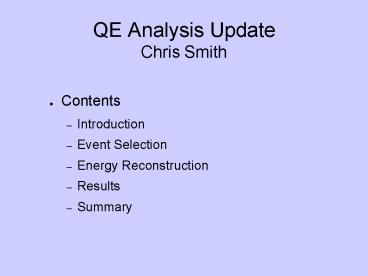QE Analysis Update Chris Smith - PowerPoint PPT Presentation
1 / 15
Title:
QE Analysis Update Chris Smith
Description:
Analysis of QE events can provide a valuable cross-check of results from full analysis ... By changing PID parameter which discriminates between QE and CC, relative ... – PowerPoint PPT presentation
Number of Views:271
Avg rating:3.0/5.0
Title: QE Analysis Update Chris Smith
1
QE Analysis UpdateChris Smith
- Contents
- Introduction
- Event Selection
- Energy Reconstruction
- Results
- Summary
2
Introduction
- Analysis of QE events can provide a valuable
cross-check of results from full analysis - Different systematics to full analysis
- Independent of energy calibration
- Lower statistics
- Using reconstructed MDC files to
- Evaluate reco performance wrt QE events
- Find PDFs for likelihood event selection
- Perform oscillation parameter fits to obtain
confidence limits
3
Event Selection
- Looked at a number of variables to discriminate
QE, CC, NC - Initial cut demand 1 reconstructed event and 1
reconstructed track - Efficiencies QE 88, CC 70, NC 15
4
Event Selection previously...
- Previously, for QE selection
- Variables ave dEdx, chg ratio, (prange-pcurv)/p
for NC/CC discrim - Cut on Etrack/Etotal for QE selection
5
Event Selection previously...
- This resulted in the following energy spectrum
- Selection efficiencies QE 40 CC 20 NC 5
- Sample fractions QE 30 CC 65 NC 5
6
Event Selection
- Want to remove dependency on reconstructed shower
energy - Look at hit fraction in track
- NC-like CC events typically have higher Y and
QE-like have lower Y as expected
7
Event Selection
- Use Track Hit Fraction, Charge Ratio, Average
dEdx distributions in a likelihood calculation - Construct PID Parameters
- PIDParQECC -log(ProbCC)1/2 -
-log(ProbQE)1/2 - PIDParQENC -log(ProbNC)1/2 - -log(ProbQE)1/2
Cut on PIDPars in 2D to select QE-like events
8
Event Selection
9
Event Selection
- True neutrino energy spectrum for selected events
- Selection efficiency by event type
10
Energy Determination muon
- (True-Reco)/True when fitting only to central
peak - Curvature mean -0.027 sigma 0.070
- Range mean 0.016 sigma 0.056
11
Energy Determination neutrino
- Estimate neutrino energy from muon momentum and
angle using relation - E? (mN E? - m?2/2) /(mN - E? P?cos??)
- For true QE events, mean 2.2 - related to
momentum offset?
12
Fits
- Carried out single experiment for 7.4, 16e20 POT
and sin22theta1, dm20.002 - Including systematic errors at 2 level for
normalisation and energy shift
13
Resolution Vs Statistics
- By changing PID parameter which discriminates
between QE and CC, relative contribution of CC
events can be varied
14
Resolution Vs Statistics
- Find minimum contour size by playing off energy
resolution vs stats - A cut of -0.2 on the PID parameter gives you the
best measurement - Analysis does not currently include systematics
related to the DIS event fraction present how
much will this change the contours?
15
Summary
- Reconstruction finds tracks in 90 of QE snarls
- Muon energy reco gt neutrino energy reco good to
2 - Event Selection
- QE selection efficiency 70 level
- QE sample purity 40
- NC background at a very low level lt1
- CC DIS dominates energy spectrum
- Energy resolution vs statistics vs systematics
needs to be understood - Closer links with NearDet Physics group after
this meeting will help to accomplish this































